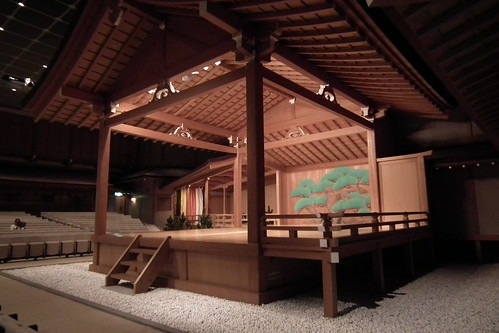As you would expect, there is no visit I could do to no matter what Japanese city where I do not look for the opportunity of seeing a traditional theatre performance, a kind of theatre that I admire and enjoy very much. In May 2011, in Tokyo, I could only go to see Kyogen, which is a comic performance that normally accompanies Noh plays. As it took place inside a theatre I was not allowed to take any pictures or video of the performance, but I could take some shots of the building and of the beautiful "stage" of the National Noh Theatre (国立 能 楽 堂).
Contemporary Noh and Kyogen theatres are theatres within theatres, as if the space for Noh were a permanent stage: the spectacular wooden theatre (which has not changed in form or building materials since the sixteenth century) is surrounded by a modern event space, with the consequent addition of seats where originally there was just an open space for spectators in Shinto temples.
Contemporary Noh and Kyogen theatres are theatres within theatres, as if the space for Noh were a permanent stage: the spectacular wooden theatre (which has not changed in form or building materials since the sixteenth century) is surrounded by a modern event space, with the consequent addition of seats where originally there was just an open space for spectators in Shinto temples.
The lighting, which is modern, is directed to the "stage" (to the original Noh theatre) in a completely open way, with no changes during the performance and no adding any kind of "atmosphere". Occasionally during evening performances in temples or outdoors at festivals (I saw one in Osaka with the actors on a boat, for example) torches are used, giving a very special effect on the atmosphere, but the use of electrical light as part of a production’s design is never seen.
This Kyogen performance had a special meaning for me because, for the first time in my life, I was attending a performance of Japanese theatre with subtitles that translated everything to English; every seat in the theatre had a screen, you could choose between Japanese and English, and so you could follow the performance without focusing only on the movements and the music (which can be interesting but also very tiring). A wonderful addition for those of us who do not speak Japanese, because it really turns that performance into an event that is very enjoyable in every sense; for the first time in my life I could laugh watching Kyogen through understanding the verbal element and not only through visual cues. These are treasures of modernity that are well appreciated.
 |
| Screen with subtitles at the Noh National Theatre (国立能楽堂). Tokyo, Japan. (Gustavo Thomas © 2011) |
Most viewers are people over 50, many of them fall asleep just as soon as the performance starts, but a good deal of them really enjoy the show, you can tell that they are familiar with it and they know what to expect from it. It is not a ritual theatre anymore, of course, and it is not a theatre with great and famous actors and shouts of the public as in Kabuki, but it is highly respected, people applaud vigorously and shows are almost always sold out.
The Kyogen performance
 |
| Plays program at hall of the Noh National Theatre (国立能楽堂). Tokyo, Japan. (Gustavo Thomas © 2011) |
 |
| Ticket for the Kyogen performance at the Noh National Theatre (国立能楽堂). Tokyo, Japan. (Gustavo Thomas © 2011) |
Kyogen plays, in contrast to Noh, are very simple plays about earthly subjects, related with trickeries and vices, usually common people and with not very stylized movements on the stage. In the last play of that evening program, for example, The fish sermon, a drunk fisherman wants to fool people by pretending to be a monk, and when he's asked to give a sermon he starts to give a list of all the fishes he knows instead of religious sentences, as simple as that.
Just as a reference I transcribe the program with the plays performed that night which, as I mentioned earlier, was only Kyogen. There are many sites on Internet which resume Noh and Kyogen plays, so you can make a simple search on Google if you want to know more about them.
Three plays and a musical piece (about 90 minutes)
- Otoshi-Suo (The discovered gift)
- Tsuen (The tea Monk)
- Uo-Zekkyo (The fish sermon)
Texts, photographs and videos in this Blog are all author's property, except when marked. All rights reserved by Gustavo Thomas.
If you have any interest in using any text, photograph or video from this Blog, for commercial use or not, please contact Gustavo Thomas at gustavothomastheatre@gmail.com.




No comments:
Post a Comment